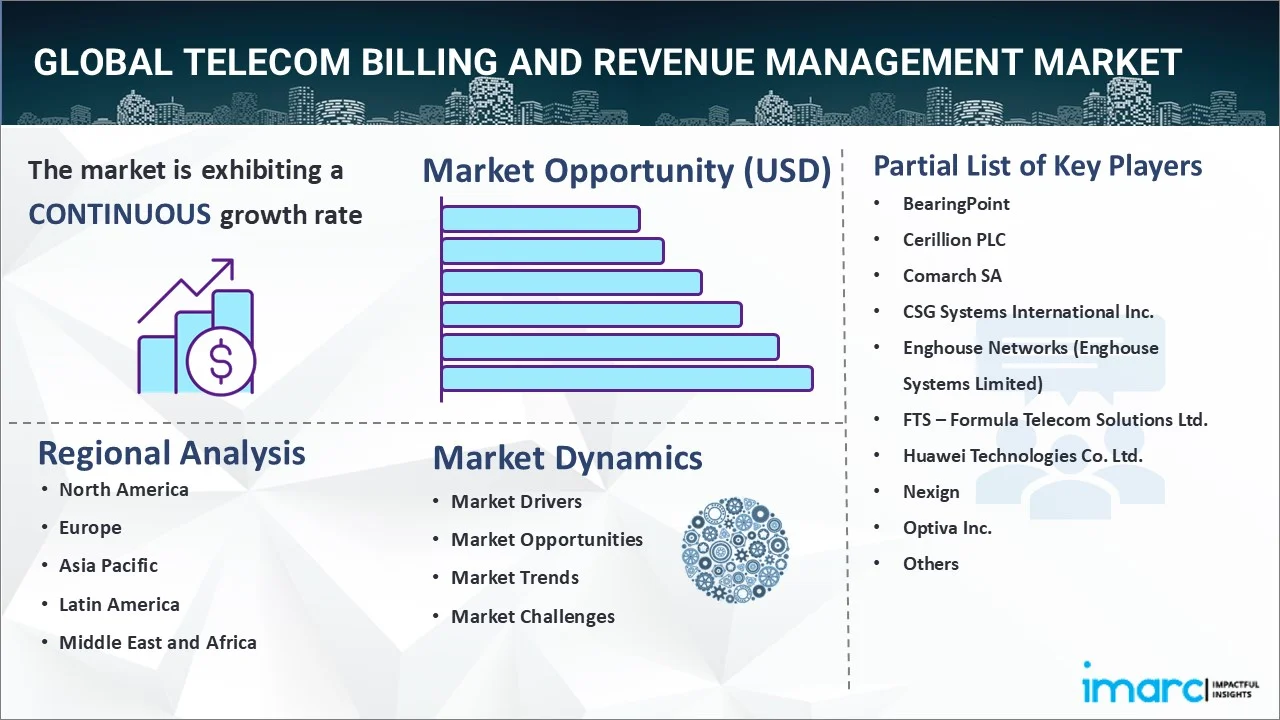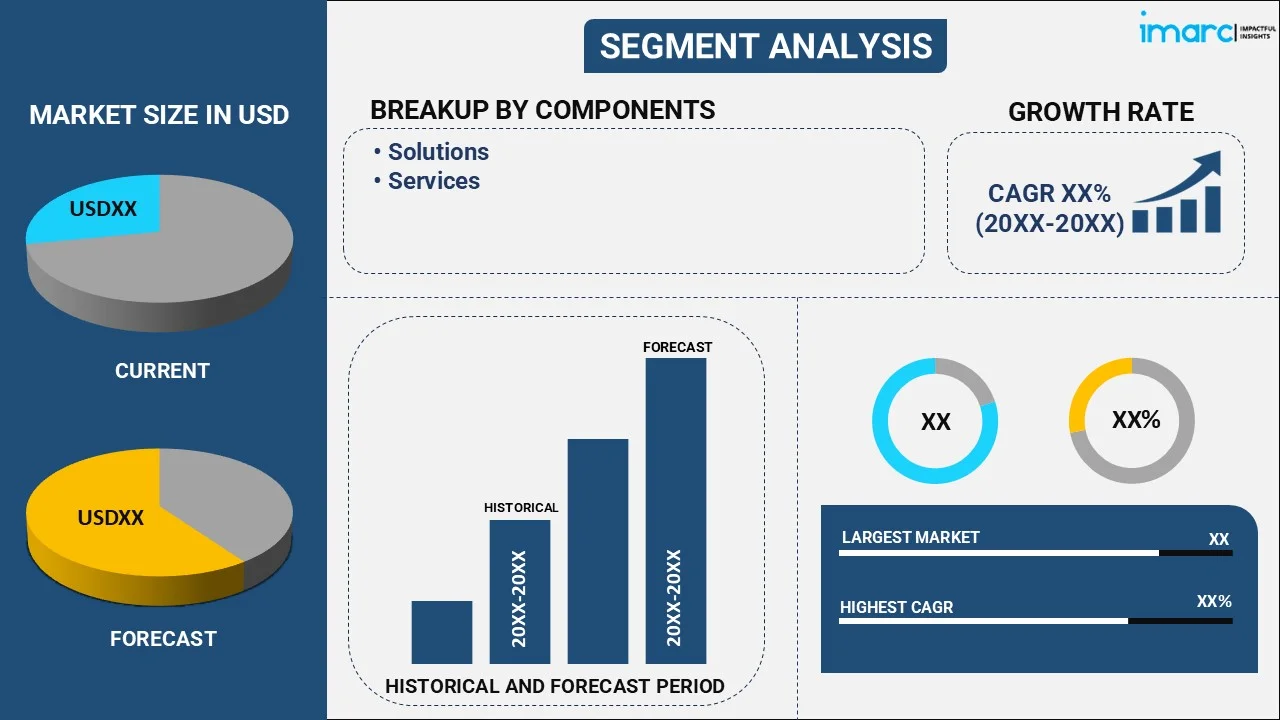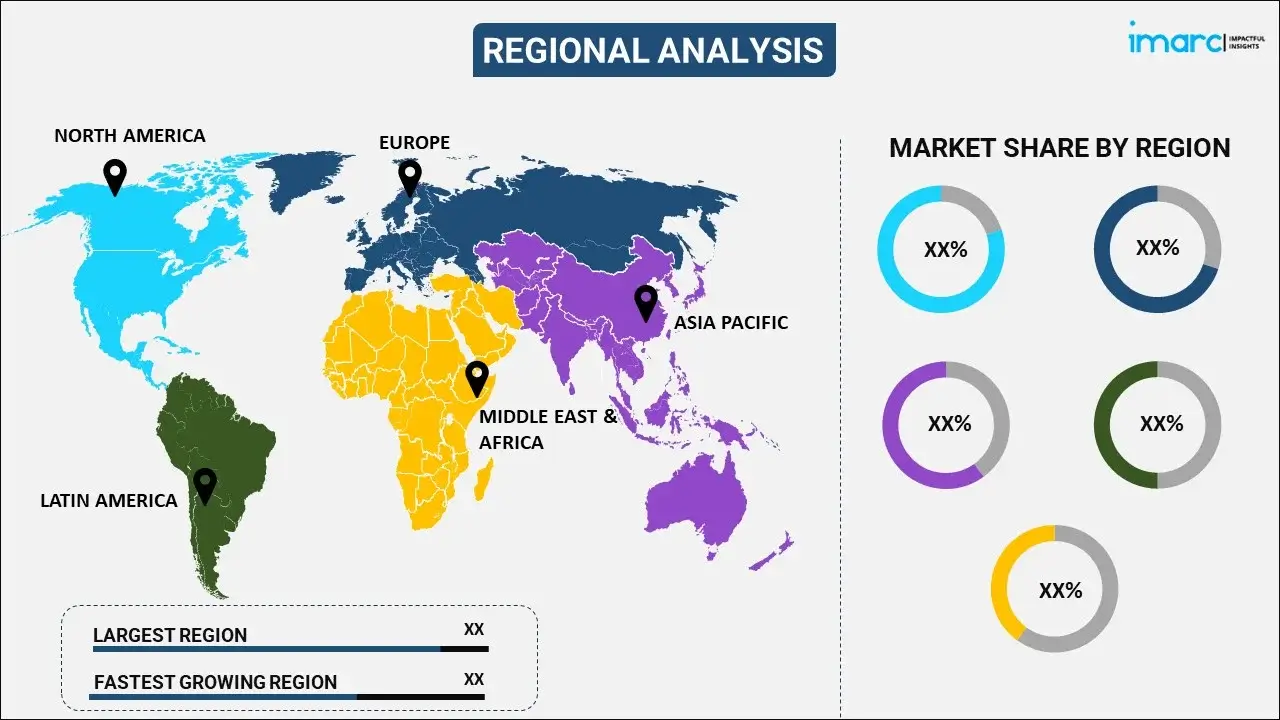
Telecom Billing and Revenue Management Market Report by Component (Solutions, Services), Deployment Model (On-premises, Cloud-based), Operator Type (Mobile Operator, Internet Service Provider), and Region 2025-2033
Market Overview:
The global telecom billing and revenue management market size reached USD 19.8 Billion in 2024. Looking forward, IMARC Group expects the market to reach USD 44.5 Billion by 2033, exhibiting a growth rate (CAGR) of 8.94% during 2025-2033. The market is being driven by the increasing demand for efficient billing systems and the integration of advanced technologies such as cloud computing and artificial intelligence. At present, North America holds the largest market share, driven by its advanced telecom infrastructure and the widespread adoption of digital billing solutions. Recent trends in the market include the implementation of cloud-based billing platforms, the integration of AI for fraud detection, and a growing focus on 5G monetization.
|
Report Attribute
|
Key Statistics
|
|---|---|
|
Base Year
|
2024 |
|
Forecast Years
|
2025-2033
|
|
Historical Years
|
2019-2024
|
| Market Size in 2024 | USD 19.8 Billion |
| Market Forecast in 2033 | USD 44.5 Billion |
| Market Growth Rate 2025-2033 | 8.94% |
Telecom Billing and Revenue Management Market Analysis:
- Major Market Drivers: Key market drivers include the rising demand for efficient billing systems due to the growing complexity of telecom services and customer plans, such as bundled services and data consumption models. The adoption of 5G and IoT technologies further pushes telecom providers to upgrade their billing infrastructure for real-time charging and revenue optimization. In line with this, increasing focus on reducing revenue leakage and fraud prevention through advanced analytics and AI-powered solutions is driving investments. The shift to cloud-based solutions also enables cost-effective scalability, supporting the growth of telecom providers in an increasingly competitive market environment.
- Key Market Trends: Key market trends include the shift toward cloud-based billing platforms, which offer enhanced flexibility, scalability, and cost efficiency for telecom operators. Integration of machine learning and AI for real-time analytics, fraud detection, and predictive revenue management, also contribute to the telecom billing and revenue management market growth. The emergence of 5G networks is also driving the adoption of real-time billing solutions to support complex pricing models and service bundling. Furthermore, customer-centric billing models, such as subscription-based services and personalized billing, are gaining traction as telecom companies seek to enhance user experience and improve customer retention in a highly competitive market.
- Geographical Trends: Geographical trends in the market shows North America leading due to its advanced telecom infrastructure and early adoption of digital billing solutions. Europe is also experiencing significant growth, driven by the expansion of 5G networks and the shift towards cloud-based billing systems. In Asia-Pacific, rapid digital transformation, growing mobile penetration, and the deployment of 5G are accelerating demand for advanced billing solutions, particularly in countries like China and India. Meanwhile, the Middle East and Africa are seeing increased investments in telecom infrastructure, with operators adopting innovative billing technologies to manage diverse service offerings and optimize revenue. According to the telecom billing and revenue management market forecast, these regions are expected to continue driving market expansion, with increasing adoption of AI-driven billing solutions and real-time revenue management tools in the coming years.
- Competitive Landscape: Some of the major market players in the telecom billing and revenue management industry include BearingPoint, Cerillion PLC, Comarch SA, CSG Systems International Inc., Enghouse Networks (Enghouse Systems Limited), FTS – Formula Telecom Solutions Ltd., Huawei Technologies Co. Ltd., Nexign, Optiva Inc., Oracle Corporation, SAP SE, among many others.
- Challenges and Opportunities: Market faces various challenges including the complexity of integrating new technologies like 5G and IoT into existing billing systems, which can be costly and time-consuming. Managing diverse billing models for bundled services and ensuring compliance with regional regulations also present hurdles. However, there are significant opportunities, such as the growing demand for cloud-based and AI-driven billing solutions, which offer real-time analytics and fraud prevention. The rise of digital services and the increasing focus on customer experience provide telecom companies with the chance to innovate their billing strategies, improve revenue streams, and enhance operational efficiency.

Telecom Billing and Revenue Management Market Trends/Drivers:
Rising number of cellular and mobile subscribers propelling market growth
There is a rise in the number of cellular subscribers across the globe, which is positively influencing the market. People are increasingly utilizing mobile phones on account of rapid digitalization around the world. There is also an easy accessibility of internet facilities along with their low prices and high speed. Besides this, people are preferring mobile phones for billing and revenue management, as they provide convenience. Consumers are also increasingly spending on numerous mobile services due to their rising need for connectivity. Furthermore, the increasing introduction of connected devices and the Internet of Things (IoT) across the globe is contributing to the growth of the market.
Increasing adoption of automated payment solutions is driving the growth of the market
There is a rise in the adoption of automated payment solutions due to their reduced costs and time-saving options. Various companies are adopting telecom billing and revenue management for gathering real-time analytics and insights into customer behavior. Telecom providers are also utilizing automated payment solutions to streamline their billing and revenue operations efficiently. In addition, key players are introducing systems that automate several processes, such as billing, inventory, service fulfillment, and product management. Apart from this, people are increasingly preferring easy to use and quick payment solutions, which is bolstering the growth of the market. Moreover, automated payment solutions provide convenient and remote-control solutions to individuals.
Growing demand for fraud detection and management positively influencing the market
Various companies are rapidly adopting telecom billing and revenue management systems to detect fraud and threats. They are also utilizing these systems, as they assist in avoiding information leakages while maintaining a unified workflow in an organization. Also, detecting frauds and threats aid in maintaining profitability in a business. Apart from this, there is a rise in awareness about cybercrimes and data breaches among the masses around the world. In line with this, the increasing utilization of telecom billing and revenue management system among service providers to deliver high-quality and interruption-free services to their customers is offering a positive market outlook.
Telecom Billing and Revenue Management Industry Segmentation:
IMARC Group provides an analysis of the key trends in each segment of the global telecom billing and revenue management market report, along with forecasts at the global, regional, and country levels from 2025-2033. Our report has categorized the market based on component, deployment model, and operator type.
Breakup by Component:

- Solutions
- Mediation
- Billing and Charging
- Revenue Assurance
- Fraud Management
- Others
- Services
- Professional Services
- Managed Services
Solutions dominate the market
The report has provided a detailed breakup and analysis of the market based on the component. This includes solutions (mediation, billing and charging, revenue assurance, fraud management, and others) and services (professional services and managed services). According to the telecom billing and revenue management market research report, solutions represented the largest segment. Various providers are offering standalone or integrated solutions that assist in evaluating, optimizing, and analyzing the billing cycle, which is contributing to the growth of the market. In line with this, the rising adoption of telecom billing and revenue management solutions, as they aid in gathering valuable insights into revenue relationships of customers and service providers, is bolstering the growth of the market.
The rising utilization of the services to achieve enhanced control and improved operational efficiency is supporting the growth of the market. Apart from this, the increasing adoption of telecom billing and revenue management services, as they benefit companies in gaining overall profitability, is strengthening the growth of the market. In addition, the escalating demand for advanced telecom services among individuals is propelling the growth of the market.
Breakup by Deployment Model:
- On-premises
- Cloud-based
On-premises holds the largest market share
A detailed breakup and analysis of the market based on the deployment model has also been provided in the report. This includes on-premises and cloud-based. According to the report, on-premises accounted for the largest market share. There is a rise in the adoption of on-premises billing and revenue management system across the globe, as it offers services to telecom operators for their end-users. In addition, the increasing utilization of on-premises systems for internal operations, such as customer care, sales, marketing and advertisement, finance and accounting, and network planning and management, is contributing to the growth of the market.
The cloud-based system can be remotely accessed by any party. Moreover, it comprises storage, application processing, networking and communication, and support services, such as training and consulting. In line with this, the increasing adoption of cloud-based systems, as they assist in reducing infrastructure costs, is propelling the growth of the market. Besides this, the growing demand for remote access to telecom billing services among individuals is offering a positive market outlook.
Breakup by Operator Type:
- Mobile Operator
- Internet Service Provider
Mobile operator accounts for the majority of the market share
A detailed breakup and analysis of the market based on the operator type has also been provided in the report. This includes mobile operator and internet service provider. According to the report, mobile operator accounted for the largest market share. Mobile operators focus on network, end-user data, and service for delivering optimum service performance and enhanced customer experience. Apart from this, the rising demand for mobile phones among individuals across the globe is propelling the growth of the market. In addition, these solutions allow mobile virtual network operators (MVNOs) and mobile network operators (MNOs) to accelerate their new solutions or service. Furthermore, the increasing automation of business processes, such as data, voice, and the Internet of Things (IoT) services, is bolstering the market growth.
Breakup by Region:

- North America
- United States
- Canada
- Europe
- Germany
- France
- United Kingdom
- Italy
- Spain
- Others
- Asia Pacific
- China
- Japan
- India
- South Korea
- Australia
- Indonesia
- Others
- Latin America
- Brazil
- Mexico
- Others
- Middle East and Africa
North America exhibits a clear dominance, accounting for the largest telecom billing and revenue management market share
The report has also provided a comprehensive analysis of all the major regional markets, which include North America (the United States and Canada); Europe (Germany, France, the United Kingdom, Italy, Spain, and others); Asia Pacific (China, Japan, India, South Korea, Australia, Indonesia, and others); Latin America (Brazil, Mexico, and others); and the Middle East and Africa.
North America held the biggest market share on account of the increasing utilization of smartphones and mobile internet. In line with this, the rising adoption of advanced technologies, such as IoT, 5G, analytics, and cloud, is contributing to the growth of the market. Apart from this, the thriving telecom industry that generates a huge amount of data is positively influencing the market in the region. In addition, the increasing demand for automated billing services is supporting the growth of the market. Besides this, the presence of key market players in the region is bolstering the growth of the market.
Competitive Landscape:
Various key players are entering into collaborations and partnerships to expand their product portfolio and upgrade and modernize solutions for improved customer security. In addition, companies are also upgrading the billing system of the network to enable 5G evolution in the market. This, coupled with the increasing demand for 5G technologies among individuals across the globe, is contributing to the growth of the market. Apart from this, key manufacturers are introducing a single billing platform to streamline management processes. Additionally, companies are deploying billing and revenue management in their business to allow a digital customer experience. They are also introducing several projects that provide automation for customer order management, a convergent billing system, and an application integration framework, which is positively influencing the market.
The report has provided a comprehensive analysis of the competitive landscape in the market. Detailed profiles of all major companies have also been provided. Some of the key players in the market include:
- BearingPoint
- Cerillion PLC
- Comarch SA
- CSG Systems International Inc.
- Enghouse Networks (Enghouse Systems Limited)
- FTS – Formula Telecom Solutions Ltd.
- Huawei Technologies Co. Ltd.
- Nexign
- Optiva Inc.
- Oracle Corporation
- SAP SE
(Please note that this is only a partial list of the key players, and the complete list is provided in the report.)
Telecom Billing and Revenue Management Market News:
- In March 2024, Hrvatski Telekom announced its partnership with Netcracker Technology to upgrade its billing system for fixed and mobile customers. The Croatian operator aims to enhance operational efficiency, reduce costs, and streamline IT operations. By implementing Netcracker Revenue Management, Hrvatski Telekom will automate its postpaid charging processes and integrate internal and external revenue management functions.
- In October 2023, Covenant Telecom announced its partnership with OneBill to transform billing and revenue management. The collaboration aims to optimize wholesale and retail billing operations while enhancing revenue management. OneBill's solution offers seamless integration with Covenant Telecom's network partners and includes essential features such as order orchestration and inventory management.
Telecom Billing and Revenue Management Market Report Scope:
| Report Features | Details |
|---|---|
| Base Year of the Analysis | 2024 |
| Historical Period | 2019-2024 |
| Forecast Period | 2025-2033 |
| Units | Billion USD |
| Scope of the Report | Exploration of Historical and Forecast Trends, Industry Catalysts and Challenges, Segment-Wise Historical and Predictive Market Assessment:
|
| Components Covered |
|
| Deployment Models Covered | On-premises, Cloud-based |
| Operator Types Covered | Mobile Operator, Internet Service Provider |
| Regions Covered | Asia Pacific, Europe, North America, Latin America, Middle East and Africa |
| Countries Covered | United States, Canada, Germany, France, United Kingdom, Italy, Spain, China, Japan, India, South Korea, Australia, Indonesia, Brazil, Mexico |
| Companies Covered | BearingPoint, Cerillion PLC, Comarch SA, CSG Systems International Inc., Enghouse Networks (Enghouse Systems Limited), FTS – Formula Telecom Solutions Ltd., Huawei Technologies Co. Ltd., Nexign, Optiva Inc., Oracle Corporation, SAP SE, etc. |
| Customization Scope | 10% Free Customization |
| Post-Sale Analyst Support | 10-12 Weeks |
| Delivery Format | PDF and Excel through Email (We can also provide the editable version of the report in PPT/Word format on special request) |
Key Questions Answered in This Report:
- How has the global telecom billing and revenue management market performed so far, and how will it perform in the coming years?
- What are the drivers, restraints, and opportunities in the global telecom billing and revenue management market?
- What is the impact of each driver, restraint, and opportunity on the global telecom billing and revenue management market?
- What are the key regional markets?
- Which countries represent the most attractive telecom billing and revenue management market?
- What is the breakup of the market based on the component?
- Which is the most attractive component in the telecom billing and revenue management market?
- What is the breakup of the market based on the deployment model?
- Which is the most attractive deployment model in the telecom billing and revenue management market?
- What is the breakup of the market based on the operator type?
- Which is the most attractive operator type in the telecom billing and revenue management market?
- What is the competitive structure of the global telecom billing and revenue management market?
- Who are the key players/companies in the global telecom billing and revenue management market?
Key Benefits for Stakeholders:
- IMARC’s report offers a comprehensive quantitative analysis of various market segments, historical and current market trends, market forecasts, and dynamics of the telecom billing and revenue management market from 2019-2033.
- The research study provides the latest information on the market drivers, challenges, and opportunities in the global telecom billing and revenue management market.
- The study maps the leading, as well as the fastest-growing, regional markets. It further enables stakeholders to identify the key country-level markets within each region.
- Porter's five forces analysis assist stakeholders in assessing the impact of new entrants, competitive rivalry, supplier power, buyer power, and the threat of substitution. It helps stakeholders to analyze the level of competition within the telecom billing and revenue management industry and its attractiveness.
- Competitive landscape allows stakeholders to understand their competitive environment and provides an insight into the current positions of key players in the market.
Need more help?
- Speak to our experienced analysts for insights on the current market scenarios.
- Include additional segments and countries to customize the report as per your requirement.
- Gain an unparalleled competitive advantage in your domain by understanding how to utilize the report and positively impacting your operations and revenue.
- For further assistance, please connect with our analysts.
 Inquire Before Buying
Inquire Before Buying
 Speak to an Analyst
Speak to an Analyst
 Request Brochure
Request Brochure
 Request Customization
Request Customization




.webp)




.webp)












